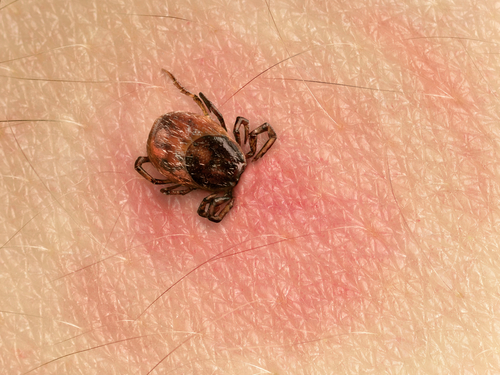Bio-Resonance Therapy for Lyme Disease
With no current cure for Lyme Disease, many people have turned to bioresonance for relief
Richard Horowitz MD wrote a book on his life’s work on Lyme and Multiple Systemic Infectious Disease Syndrome or MSIDS and we recommend his book “Why Can’t I Get Better?” if you would like to know more about the disease and co-infections. We have taken the questionnaire he used and it will calculate a score for you.
If you score 46 or more you have a high probability of a tick borne disorder and should see a health care provider.
If you score between 21 and 45 you possibly have a tick borne disorder and should see a health care provider.
If you score under 21 you are not likely to have a tick borne disorder.
Tests for Lyme
Reson8 offer bioenergetic testing for Lyme Disease, this is not the same as conventional blood tests and can find stress at a cellular level, this is very useful in helping doctors to pinpoint the actual pathogens present. In addition the positive tests can be used for inversion with interesting results as shown on the testimonial videos. For legal reasons we do not make claims as to effectiveness of the treatments. We test for the following:
Lyme Mix,
Borrelia Burgdorferi,
Borrelia Recurrentis,
Borrelia Lonestari,
Borrelia WA1,
Lyme Cyst,
Encephalitis,
Lyme Neurotoxins,
Babesia Mix,
Babesia Bigemina,
Babesia Microti,
Babesia Divergens,
Babesia WA1,
Ehrlichia Chaffeensis,
Ehrlichia Phagocytophila,
Bartonella Henselae,
Rickettsia Rickettsii,
Rickettsia Akari,
Mycoplasma Mix
Ammonia,
Superoxide,
Peroxide,
Ethane,
Superoxide Dismutase,
Nitric Oxide,
Quinolinic Acid,
Babesia Neurotoxins,
D/L Lactic Acid,
Virus,
Bacteria,
Parasite,
Yeast,
Heavy Metals,
Chemicals,
N-Acetyl Cysteine,
L-Glutamine,
ADP-Mg,
O2-Oxygen,
Glucose,
Glycogen,
Pyruvate,
Acetyl-CoA
Lyme Borreliosis

Tick with its head sticking in human skin, red blotches indicate an infection
Lyme borreliosis is a multisystemic infectious disease triggered by the Borrelia burgdorferi bacterium of the spirochete family. It can attack any organ, as well as the nervous system, joints and tissues. The disease occurs in humans and in all other mammals, as well as in birds. Transmission is chiefly by the wood tick of the genus Ixodes, and also in very rare cases by mosquitoes or horseflies.
Discovery and naming
The term ‘Lyme borreliosis’ stems from the names of the towns of Lyme in the State of Connecticut in the USA, where the syndrome was first described in 1975 following the cumulative occurrence of joint inflammation in association with tick bites, as well as from the description of the disease as a borreliosis, which can be traced back to the systematic microbiological classification (genus) of the pathogen, named after the French bacteriologist Amédée Borrel.
Pathogen
The pathogen was named Borrelia burgdorferi after its Swiss discoverer Willy Burgdorfer, who in 1981 first traced the disease to ticks and in 1982 managed to culture the previously unknown pathogen. A blood sample from the patient is examined for Borrelia- and co-infections in a special laboratory using biophysical methods. If live pathogens are detected, the test is positive. In addition to identifying the individual Borrelia species or coinfections, the severity of the infestation is determined according to a ten-level scale. The bacteria Borrelia garnii and Borrelia afzelii are presumed to be further Lyme disease pathogens, and are likewise related to the syphilis pathogen.
Lyme disease symptoms
The symptomatology of borreliosis is exceedingly complex. Many complaints caused by borreliosis can also occur in the case of other clinical pictures. For this reason, diagnosis is difficult. Similarly to syphilis, which is caused by a related pathogen, the clinical symptoms of Lyme disease are divided into three stages. It is important to bear in mind here that atypical progressions occur very frequently. It therefore makes sense not to rely too heavily on the division into stages. It should also be borne in mind that it can take weeks, months – indeed, in exceptional cases even years – for the disease to manifest. Between the individual stages of the disease, the patient may be completely free of complaints for weeks.
Legal obligation to notify the authorities: Unlike with tick-borne encephalitis, there is no obligation to notify the authorities in the case of Lyme disease. It may be, however, that a case of meningoencephalitis, which is a possible consequence of Lyme disease, has to be reported.
Experience with Lyme Treatment with Bioresonance
The Three Stages
Stage I
Erythema chronicum migrans, or Erythema migrans, may be termed the characteristic cardinal symptom of Stage I of the disease. Days to about 10 weeks after the infected tick bite, a skin rash forms around the site of the bite. The rash spreads gradually in a circle, and may also appear on different parts of the body, which is why Erythema migrans is also called ‘wandering rash’. Subsequently the erythema fades from the centre outwards, so that it is initially seen as a disc-shaped, and later as a ring-shaped redness. Erythema migrans only develops in about 50 per cent of borreliosis diseases, but is a sure sign of a borrelia infection. Further symptoms in stage I are,
• Fever • Myalgia (muscle pain) • Headache • Swelling of lymph nodes • Severe sweating episodes • Exhaustion • Concentration problems • Vertigo attacks • Summer flu like symptoms
Stage II
In the second stage, severe organ symptoms may appear weeks to months after the tick bite. Inflammatory processes in peripheral nerves (neuritises) cause pseudoradicular syndromes with often unbearable pain. Bannwarth’s meningoradiculitis may be viewed as a stage II cardinal symptom. Neurological deficits and strong pains may look like a slipped disc, with the patient experiencing pain particularly at night. The pain becomes worse under stress. Normal painkillers and non-steroidal anti-inflammatory drugs (NSAIDs) are of little help.
Very often, sensory and neurological disorders occur. The neurological disorders may occasionally be confused with carpal tunnel syndrome; patients have in the past been operated on based on such a misdiagnosis. Complete motor failure occurs fairly rarely, however. Occasionally, cranial-nerve failure occurs. This most often involves paralysis of the facial nerve (Nervus facialis), so-called peripheral facial paresis. The frequency of facial paresis is overestimated, however, possibly because of the fact that in many cases, facial paresis prompts the suspicion of Lyme disease. The following also occur frequently:
• Headaches radiating out from the nape of the neck • Vertigo attacks • Visual disturbances • An increased resting pulse
A number of sufferers sometimes wake up with palpitations. Acute Lyme carditis can lead to myocardial insufficiency with enlargement of the heart. A typical yet fairly infrequent cutaneous manifestation of stage II is Lymphadenosis benigna cutis Bäfverstedt (borrelia lymphocytoma). This manifests as a reddish-to-pale-bluish tumour, usually on the earlobes, nipples or scrotum.
Stage III
Months to years after the tick bite, late stage symptoms may set in. The following are especially typical:
• Arthritises (Lyme arthritis – jumps from joint to joint) • Myositis (muscle inflammation) • Bone pain • Fibromyalgia • Acrodermatitis chronica atrophicans Herxheimer (ACA) • Encephalomyelitis
ACA is characterised by ‘doughy’, swollen, purple skin, especially on the hands and feet. The extensor sides of the joints are particularly affected. Later, the skin progressively atrophies. It becomes as thin as tissue paper and looks increasingly transparent. Chronic encephalomyelitis is a relatively rare late sequela of the disease. The clinical picture of a stroke may also be mimicked in the late stage. Actual vascular occlusions can even occur. Only the evidence of the relevant antibodies in the cerebrospinal fluid can prove that a borrelia infection is the cause of these vascular occlusions. The angiogram shows no differences.
How are the Pathogens transmitted?
Borrelia burgdorferi is almost always transmitted by a tick bite. Soft ticks and sheep ticks are shed from stalks and low bushes. Soft ticks, however, deliberately make their way towards their victim. Like all insects, ticks follow an attractant to reach their target. The most important attractant for ticks is butyric acid, a decomposition product found particularly in fairly old human sweat.
Borrelia is primarily transmitted by the sheep tick (Ixodes ricinus) in Europe, by Ixodes dammini and Ixodes pacificus in America, and by Ixodes persulcatus in East Asia. Because the bacterium is found in the midgut of the tick, the pathogen is not transmitted immediately at the time of the tick bite, as is the case with the TBE pathogen. Normally, Borrelia burgdorferi passes into the human body at the very earliest approximately 12 to 24 hours after the tick bite, along with the excretions of the tick into the body of its human host.
If you spot a sucking tick on your body before this time period has elapsed, an infection is fairly unlikely. You should remove the tick as swiftly as possible, and in the proper way. This is important to prevent the gut contents of the tick from entering your body via the puncture channel when the tick is removed. Under no circumstances should you throw away the tick; it can be examined for the presence of Borrelia burgdorferi (send the tick to the lab along with a blood sample from the patient). Although other transmission pathways are rare, they do occur.
Hence, Borrelia burgdorferi also seems to be transmitted via a species of biting fly found chiefly in the vicinity of pastures. Transmission of Lyme disease through fly-, mosquito-, horsefly- and flea-bites as well as a wasp sting is thought to be possible. If a ‘wandering rash’ occurs after such a bite or sting, you should go to the doctor’s at once.
How can I protect myself?
The best way to prevent lyme disease is to avoid tick bites by making sure that infected ticks can’t get to the skin.
• Ideally, wear fresh, light-coloured clothing • Long trousers • Long socks – in forest areas pull up over trouser legs if necessary • Long sleeves
Immediately after spending time outdoors you should change your clothes after first examining your body.
Detecting lyme infections
Information, article, studies, interviews on Lyme disease and other diseases transmitted by ticks Lyme borreliosis is a multiorgan systemic disease which in principle can attack any organ but which manifests chiefly in the skin, nerves, the joint, tendon and muscular system and the heart. Despite the impression to the contrary – frequently given in public – the diagnosis and therapeutic monitoring of Lyme infection is characterised by numerous difficulties, which can lead to misdiagnoses both in terms of false-positive as well as false-negative findings.
The laboratory diagnosis of this disease is based primarily on indirect serological testing such as ELISA or EIA and Immunoblot (or Western Blot). These tests, however, can only identify the antibodies that have formed as a result of the conflict between host and pathogen. Consequently, no statement on pathogen activity can be made. This is also why these tests are not suitable for therapeutic monitoring.
Direct detection of pathogens by culture, and alternatively, DNA detection through PCR (polymerase chain reaction) are also used in cases where this examination would be indicated, but are not yet part of routine diagnostics. In addition, there is the matter of laboratory diagnosis not being standardised. For this reason, one laboratory’s test can yield positive results whilst another’s yields negative results. An assessment to diagnose lyme disease based on symptomatology can be difficult if no disease manifestations typical of borreliosis occur during the course. This is because Lyme borreliosis can also cause numerous disease manifestations that may also occur in the case of illnesses with other causes.
Since reliable therapy markers are absent with which a cure in the sense of the elimination of the pathogen can be determined with a sufficiently high degree of probability, the study material for treatment is also inadequate and contradictory in terms of results. In addition, placebo-controlled studies on the efficacy of the antibiotics normally used and of the therapy regime based on them are lacking. What constitutes the ideal antibiotic therapy (type of antibiotic, dosage, length of treatment, repeat courses) according to the form and stage of the disease is therefore a contentious subject.
Ticks can transmit a whole other range of pathogens to humans, inter alia the TBE (tick-borne encephalitis) virus as well as human-pathogen species of Babesia, Anaplasma (Ehrlichia) and Rickettsia. Lyme disease is often confused with TBE, which occurs endemically in only a few regions of Germany and leads to between 300 and 500 new cases per year. Whilst there is a vaccine for TBE, there is as yet no Lyme disease vaccine available.
Against this background, for almost two decades there have been wide-ranging medical controversies on the prevention, pathogenesis, diagnosis, treatment and therapeutic monitoring of this disease. Whilst in the USA these have for many years led to massive public debates, these controversies do not seem to have penetrated public awareness in the German-speaking countries of Europe.
The care and research situation in Germany and the EU in this sphere can be described as extremely poor. Urgently needed improvements are attempted only hesitantly or half-heartedly, if at all.
Despite its epidemiological scope, the disease leads a decidedly shadowy existence in terms of research promotion and health-policy prioritisation. Patients who have been diagnosed with Lyme disease or who are suspected of having it often become lost in a labyrinth of contradictory medical opinion.
The fact that around 100,000 people in Germany suffer from chronic Lyme disease and that approx. 50,000 to 120,000 acute new infections – of which one-third will become chronic – are added to that each year, should be reason enough to deal in greater depth with this insidious infection.
Removing ticks
Suitable tools for removing ticks can be purchased at the pharmacy. Anyone who is unsure how to use tick cards or tick tweezers should seek assistance from their doctor or therapist. The general rule is: the quicker, the better! The use of old home remedies such as glue or oil is to be completely discouraged. These methods cause the death of the tick through suffocation, before which it vomits into the wound. It is at this point that infectious material enters the bloodstream.
Borreliae in the immune system
As bacteria, Borreliae live in principle extracellularly; however, they can also survive intracellularly. For this, they do not prefer any particular host cell over another. In this way, they can temporarily elude the host’s defences, since they become ‘invisible’ to the immune system when in the host’s cell.
Borrelia can vary from a highly active spiral form to a fairly inactive spherical form. It is thus capable of surviving unfavourable situations such as a rise in temperature owing to fever, pH fluctuations in the colloidal fluid and antibiotics treatment. This inactive spherical form can be maintained for about 3 weeks. For this reason, treatment must be of the appropriate length in the case of targeted antibiotic treatment. Borrelia’s shapeshifting ability might also explain the typical course of the disease in phases, sometimes with long symptom-free periods.
When Borreliae are in their active – i.e. spiral – form, they can move through tissue, just like our defence cells. This means that they can spread very rapidly, even in tissue with a very limited blood supply.
In their spherical, fairly inactive variant, they are spread – virtually unrecognised by the body’s defence mechanisms – via the bloodstream, and hence extremely quickly.
The pathogen is capable of modifying our antibodies, the cytokines. Thus, the regulatory relationship of aggression and suppression mechanisms in our immune system is modified to the detriment of aggression. From this alone, Lyme disease’s essential tendency towards chronicity can be explained.
It would appear that Borreliae are able to alter their surface proteins at frequent intervals. This would modify the specific recognition code, leaving our defences only able to react belatedly and slowly.
The body’s own cells, i.e. those belonging to the system, have a standard recognition code relating to their own antibodies and defence cells (factor H).
Borreliae are apparently able to bind this factor H to themselves. In this way, they appear to the defence system to be a part of the body, and are not therefore attacked. In this situation, the immune system must increase both the irritability and the sensitivity of its defences in order to overcome the pathogen. This could be the reason why Lyme disease is even nowadays still often misdiagnosed as a ‘rheumatic’ ailment.
Article: Lyme – What you’re not being Told
How to treat lyme disease
Treatment and case studies can be found in the conference paper sections
New Lyme Book by Paulette Agnew



